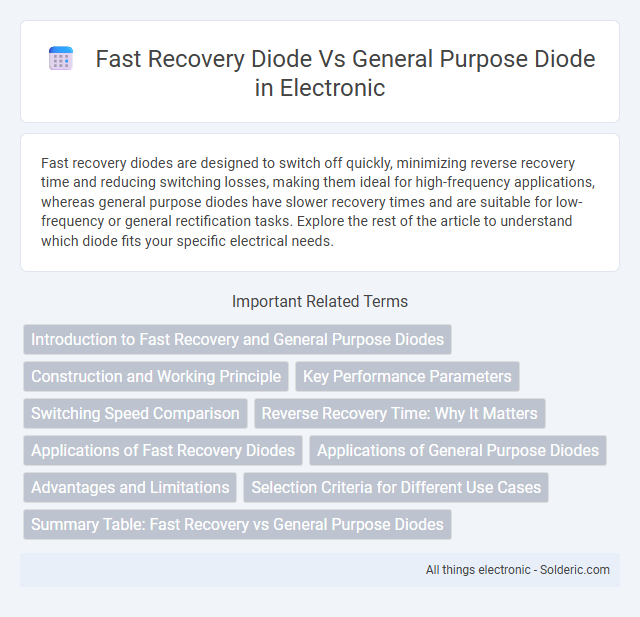Fast recovery diodes are designed to switch off quickly, minimizing reverse recovery time and reducing switching losses, making them ideal for high-frequency applications, whereas general purpose diodes have slower recovery times and are suitable for low-frequency or general rectification tasks. Explore the rest of the article to understand which diode fits your specific electrical needs.
Comparison Table
| Feature | Fast Recovery Diode | General Purpose Diode |
|---|---|---|
| Recovery Time | Typically < 100 ns | Typically > 1 us |
| Switching Speed | High-speed switching | Low-speed switching |
| Applications | Switch mode power supplies, inverters, high-frequency circuits | Rectification in low-frequency circuits, power supplies |
| Reverse Recovery Charge | Low | High |
| Forward Voltage Drop | Typically 0.7 V | Typically 0.7 V |
| Cost | Higher | Lower |
| Typical Part Numbers | 1N4937, UF4007 | 1N4001, 1N4148 |
Introduction to Fast Recovery and General Purpose Diodes
Fast recovery diodes feature a significantly shorter reverse recovery time compared to general purpose diodes, making them ideal for high-frequency switching applications. General purpose diodes, designed for standard rectification tasks, prioritize durability and cost-effectiveness over speed of recovery. Your choice between these diodes depends on the switching speed and efficiency requirements of your electronic circuit.
Construction and Working Principle
Fast recovery diodes feature a p-n junction designed to minimize stored charge, enabling rapid switching by quickly eliminating minority carriers during reverse recovery, unlike general purpose diodes that have higher charge storage and slower recovery times. Constructed with narrower depletion regions and optimized semiconductor materials, fast recovery diodes reduce reverse recovery time significantly, improving efficiency in high-frequency applications. General purpose diodes possess a standard p-n junction with thicker depletion layers, resulting in slower response and increased power loss during switching events.
Key Performance Parameters
Fast recovery diodes feature significantly shorter reverse recovery times, typically in the range of nanoseconds, compared to general purpose diodes which often exhibit reverse recovery times in microseconds. This results in reduced switching losses and higher efficiency in high-frequency applications such as power converters and inverters. Additionally, fast recovery diodes usually have lower junction capacitance and optimized forward voltage drops, enhancing their performance in fast switching circuits versus the broader, less specialized usage of general purpose diodes.
Switching Speed Comparison
Fast recovery diodes exhibit significantly shorter reverse recovery times compared to general purpose diodes, enabling quicker switching speeds and reduced switching losses in high-frequency applications. General purpose diodes typically have longer recovery times, which can result in increased power dissipation and slower response during rapid switching events. The enhanced switching speed of fast recovery diodes makes them ideal for use in switching power supplies, inverters, and motor control circuits where efficiency and performance are critical.
Reverse Recovery Time: Why It Matters
Fast recovery diodes have significantly shorter reverse recovery times compared to general purpose diodes, enabling quicker transition from conducting to blocking state. This characteristic reduces switching losses and electromagnetic interference in high-speed circuits, improving overall efficiency and performance. Your choice of diode impacts the reliability and speed of power electronics, especially in applications like inverters and switching power supplies.
Applications of Fast Recovery Diodes
Fast recovery diodes are crucial in high-frequency switching applications such as power supplies, inverters, and motor drives due to their ability to quickly switch off and minimize energy loss. Your circuits benefit from reduced switching losses and improved efficiency when using fast recovery diodes compared to general purpose diodes, which have slower recovery times. These diodes are also essential in protecting transistors in high-speed rectification and snubber circuits where rapid response is needed.
Applications of General Purpose Diodes
General purpose diodes are widely used in low-frequency rectification, signal demodulation, and voltage clamping due to their reliable switching characteristics and cost-effectiveness. These diodes handle moderate current and voltage levels, making them suitable for power supplies, audio signal processing, and protection circuits in consumer electronics. Their slower recovery time compared to fast recovery diodes limits their use in high-speed switching applications but ensures robustness in standard rectification tasks.
Advantages and Limitations
Fast recovery diodes offer significantly reduced reverse recovery time compared to general purpose diodes, making them ideal for high-speed switching applications and improving overall efficiency in power electronics. However, they typically exhibit higher forward voltage drops and increased cost, which may limit their use in cost-sensitive or low-frequency circuits where general purpose diodes perform adequately. Your choice between these diodes should consider application speed requirements and design constraints to optimize circuit performance.
Selection Criteria for Different Use Cases
Fast recovery diodes are selected for high-frequency switching applications due to their low reverse recovery time and reduced switching losses, making them ideal in power supplies, inverters, and motor drives. General purpose diodes suit low-frequency or non-critical circuits where switching speed and efficiency are less crucial, such as simple rectification tasks and signal demodulation. Key selection criteria include switching speed, reverse recovery time, forward voltage drop, and the specific requirements of frequency, efficiency, and thermal performance in the intended use case.
Summary Table: Fast Recovery vs General Purpose Diodes
Fast recovery diodes feature significantly shorter reverse recovery times compared to general purpose diodes, making them ideal for high-frequency switching applications. Their lower junction capacitance and reduced switching losses enhance efficiency in power converters and inverters, while general purpose diodes excel in low-speed, less demanding circuits due to their simplicity and cost-effectiveness. Your choice between fast recovery and general purpose diodes should consider switching speed, efficiency requirements, and thermal performance reflected in this comparison.
Fast recovery diode vs general purpose diode Infographic

 solderic.com
solderic.com